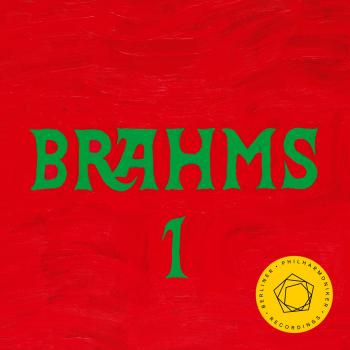
Mahler: Symphony No. 6 Berliner Philharmoniker & Kirill Petrenko
Album info
Album-Release:
2020
HRA-Release:
26.03.2021
Label: Berlin Philharmonic Orchestra
Genre: Classical
Subgenre: Orchestral
Artist: Berliner Philharmoniker & Kirill Petrenko
Composer: Gustav Mahler (1860 – 1911)
Album including Album cover Booklet (PDF)
- Gustav Mahler (1860 - 1911): Symphony No. 6:
- 1 Symphony No. 6: I. Allegro energico, ma non troppo 23:14
- 2 Symphony No. 6: II. Andante moderato 13:51
- 3 Symphony No. 6: III. Scherzo. Wuchtig 12:18
- 4 Symphony No. 6: IV. Finale. Allegro moderato 27:59
Info for Mahler: Symphony No. 6
Deadly Serious, Forgoing Hope - Gustav Mahler’s Sixth Symphony
“I am thrice homeless: as a Bohemian among Austrians; as an Austrian among Germans; and as a Jew everywhere in the world,” was Mahler’s bitter conclusion about his status vis-à-vis humanity and, especially, art. On the other hand, he had already prophesied early on, “My time will come”, and he remained relatively sanguine in the face of setbacks that bedevilled him as a composer from the outset, putting them in a sort of historical context. He turned out to be right: for decades his works have enriched the symphonic repertoire as a core component of the music offering a reflection of the world we live in.
Military influences: Mahler spent his childhood in Iglau (now Jihlava), a predominantly German-speaking market and industrial town on the Bohemian-Moravian border. Near his family home were the barracks of an Austrian garrison whose “morning and evening calls, assembly and drill motifs he transformed into sound-images,” recalled the Moravian-born musicologist Guido Adler of his late friend. “They emerge again and again as vivid re-creations in both the songs and instrumental works of later times ... This background also explains Mahler’s partiality for march rhythms of all types; they are found throughout his work, accompanying joy and sorrow.” The far closer proximity of war and military personnel to daily life in former times is reflected in the poems from Des Knaben Wunderhorn; over half of Mahler’s settings from this collection more or less deal with diverse facets of a soldier’s life. Although it goes without saying that the composer’s youthful impressions (“Military music – my delight throughout my childhood”) did not lead him to a glorification of warfare, this ongoing lifelong fascination helped Mahler to find his own “tone of voice”, one shot through with an irony that unites “joy and suffering”. None of his other symphonies feature the march as a prototype of military music as prominently as the Sixth. The taut rhythm that defines long stretches of this work stamps the whole of the first and fourth movements. Even the Scherzo occasionally tips from inscrutable burlesque into a quick march with shifts between triple and quadruple metre. The sheer weight of the massive orchestration, with eight horns, six trumpets, four trombones, tuba and huge percussion, along with frequent calls for maximum loudness, awakens the impression of powerful military companies.
Genesis in summer: Mahler wrote the Sixth Symphony during the summers of 1903 and 1904. As always, ever since he embraced the conducting profession at the age of 21 in Ljubljana (then Laibach), he had only the theatre-free months of July and August for composition. In those few weeks on holiday in the Carinthian village of Maiernigg, he needed to concentrate his creative activity, sketching and elaborating his works as far as possible, because during the season he had the energy and time only for orchestration and preparing fair copies. The composition of the Sixth was finished in Vienna on 1 May 1905.
One would imagine this to have been the happiest time of his life. As director of the Vienna Court Opera, Mahler was unchallenged, and the drudgery he had endured since 1897 to attain higher, worthy standards (“What you theatre people call your tradition is nothing but your laziness and sloppiness”) had borne fruit. As a concert conductor he was internationally renowned, especially in The Netherlands, where he conducted the Concertgebouw Orchestra for the first time in 1903. His marriage to Alma Schindler produced two daughters (Maria Anna in 1902, Anna Justine in 1904). The sun shone on his professional and personal lives. Or did it only seem to shine? In either case, the new symphony was very soon given the nickname “Tragic” – admittedly not by Mahler, though he didn’t disown it.
A long march: The first movement (Allegro energico, ma non troppo) is akin to the marching song already prefigured in Mahler’s Wunderhorn lied “Revelge”. Its three themes – a jagged opening idea, a chorale-like passage and a passionately soaring lyrical theme – all seem to be driven by the firm forward impulse. Introduced just before the chorale is the leitmotif of the whole symphony: a direct clash of major and minor chords, primed by the knocking of fate in the timpani rhythm. The development section, which begins classically by “working out” and playing with the themes, suddenly leads into a completely different world: a dreamlike recollection of something distant, highlighted by the sound of cowbells. But in the background the march is still carrying on, and it emerges again as though it had never been silenced. The movement concludes almost precipitously, its ending seeming less of a full stop than a colon.
The Andante – a more impassioned sister of the Fifth’s Adagietto – is pervaded by reminiscences of the fourth of the Kindertotenlieder (“Oft denk’ ich, sie sind nur ausgegangen”), and the climax – both in dynamics and emotion – near the end of the movement hints at the distresses to come. The Scherzo introduces a note of quirkiness; the old-fashioned homeliness keeps stumbling over conflicting accents and metre changes. The enormous Finale seems like a reversal of what has transpired so far. Everything in the opening march that “strived for a breakthrough, for fulfilment, now gets caught up in a maelstrom of collapse and destruction” (musicologist Mathias Hansen), but even here infiltrated by islands of deceptive jubilation and arduously evoked idylls. “The bells of grazing herds are the last things a person hears while ascending the lonely Alpine peaks” – Mahler spectrally embraced this observation of his mountain walks in three of the four movements. At the Finale’s climactic points the symphony’s famous hammer blows are sounded (Mahler reduced their number from five in the draft to three in the first version and, finally, to two), until, in the radically abbreviated coda, the motifs crumble like timbers grown brittle and the movement – sinking almost inaudibly into oblivion after an epic half hour – not so much ends as breaks off with a sudden tutti outburst in A minor.
“How can I be happy?”: The musicologist Hans Ferdinand Redlich understood “Mahler’s music as an expression of the instinctive forebodings of a great artist ... who, as spokesman for the ‘suppressed and aggrieved’ of this world, could perceive the distant rumblings of the future. Seen from this viewpoint, the Sixth Symphony foretells the horrors that have arisen in this century of two worldwide conflicts and the misery inflicted on minorities ... who found in Mahler, the old-Austrian Jew, their most sympathetic interpreter. In the light of such philosophical experience, the catastrophe of the Sixth Symphony’s finale can be called ‘cosmic’ and its ‘hero’ understood as a community of all the sufferers in this world.”
Mahler was sceptical of programmes, writing in a letter that “starting with Beethoven, there has been no modern music without its underlying programme. – But no music is worth anything if you first have to tell the listener what experience lies behind it.” The tone of this symphony, so deeply serious, so devoid of hope, corresponds to Mahler’s guiding principle, borrowed from Dostoevsky’s novel The Brothers Karamazov: “How can I be happy when somewhere another creature is suffering?” This motto suggests that personal withdrawal and extra-professional contentment were not possible for Mahler, that he always saw himself in a larger context, both as man and artist: one who created not outside of the world but rather from out of its midst, seeking – and this is what writing a symphony meant for him – to “create a world”. A better world perhaps. Its time is still to come. (Malte Krasting)
Berliner Philharmoniker
Kirill Petrenko, conductor
Kirill Petrenko
was born in Omsk, Siberia, in 1972 and studied piano at the school of music there. He appeared in public as a pianist for the first time at the age of eleven with the symphony orchestra in Omsk. In 1990 he moved with his family (father violinist, mother musicologist) to Vorarlberg, Austria, where his father accepted a position as an orchestral musician and music teacher. Petrenko continued his studies in Feldkirch, then studied conducting at the University of Music and Performing Arts in Vienna.
His first engagement took him to the Wiener Volksoper as assistant and Kapellmeister immediately after graduation. From 1999 to 2002 Kirill Petrenko was general music director at the Theater Meiningen, where he attracted international attention for the first time in 2001 with a production of Wagner’s Der Ring des Nibelungen, directed by Christine Mielitz with sets by Alfred Hrdlicka. In 2002 Kirill Petrenko began his tenure as general music director of the Komische Oper Berlin, where he conducted a series of impressive productions until 2007.
Petrenko’s international career developed rapidly during his years in Meiningen and Berlin. In 2000 Kirill Petrenko made his debut at the Maggio Musicale in Florence, in 2001 at the Wiener Staatsoper and the Semperoper in Dresden, in 2003 at the Gran Teatre del Liceu in Barcelona, the Opéra National de Paris, the Royal Opera House, Covent Garden in London, the Bayerische Staatsoper and New York’s Metropolitan Opera, and in 2005 at the Frankfurt Opera. From 2006 to 2010 he presented a cycle of Tchaikovsky’s three Pushkin operas with Peter Stein in Lyon.
After leaving the Komische Oper Berlin Kirill Petrenko worked as a freelance conductor.
In addition to his operatic career Kirill Petrenko has also appeared on concert stages throughout the world. He has collaborated with leading orchestras such as the Berliner Philharmoniker, the Staatskapelle Dresden, the Bavarian Radio Symphony Orchestra, the Bayerisches Staatsorchester, the WDR Symphony Orchestra Cologne, the Hamburg Philharmonic Orchestra, the NDR Symphony Orchestra Hamburg, the Frankfurt Opera and Museum Orchestra, the Concertgebouw Orchestra in Amsterdam, the Vienna Philharmonic, the Vienna Radio Symphony Orchestra, the Vienna Symphony Orchestra, the Cleveland Orchestra, the Chicago Symphony Orchestra, the London Philharmonic Orchestra, the Oslo Philharmonic Orchestra, the Orchestra Santa Cecilia in Rome, the RAI Orchestra in Turin and the Israel Philharmonic Orchestra.
Kirill Petrenko has also conducted concerts at the Bregenz and Salzburg Festivals.
From 2013 until 2015 he conducted the new production of Richard Wagner’s Der Ring des Nibelungen at the Bayreuth Festival.
Kirill Petrenko began his tenure as general music director of the Bayerische Staatsoper on September 1, 2013. Since then he conducted, besides a huge number of revivals, the premieres of Die Frau ohne Schatten (Richard Strauss), La clemenza di Tito (Wolfgang Amadeus Mozart) and Die Soldaten (Bernd Alois Zimmermann), Lucia di Lammermoor (Gaetano Donizetti), South Pole (Miroslav Srnka, world premiere), Die Meistersinger von Nürnberg (Richard Wagner), Alban Berg’s Lulu, Giacomo Puccini’s Il trittico and Richard Wagner’s Parsifal.
In June 2015 Kirill Petrenko was elected as the next chief conductor of the Berlin Philharmonic as of the 2019/20 season.
Booklet for Mahler: Symphony No. 6




















